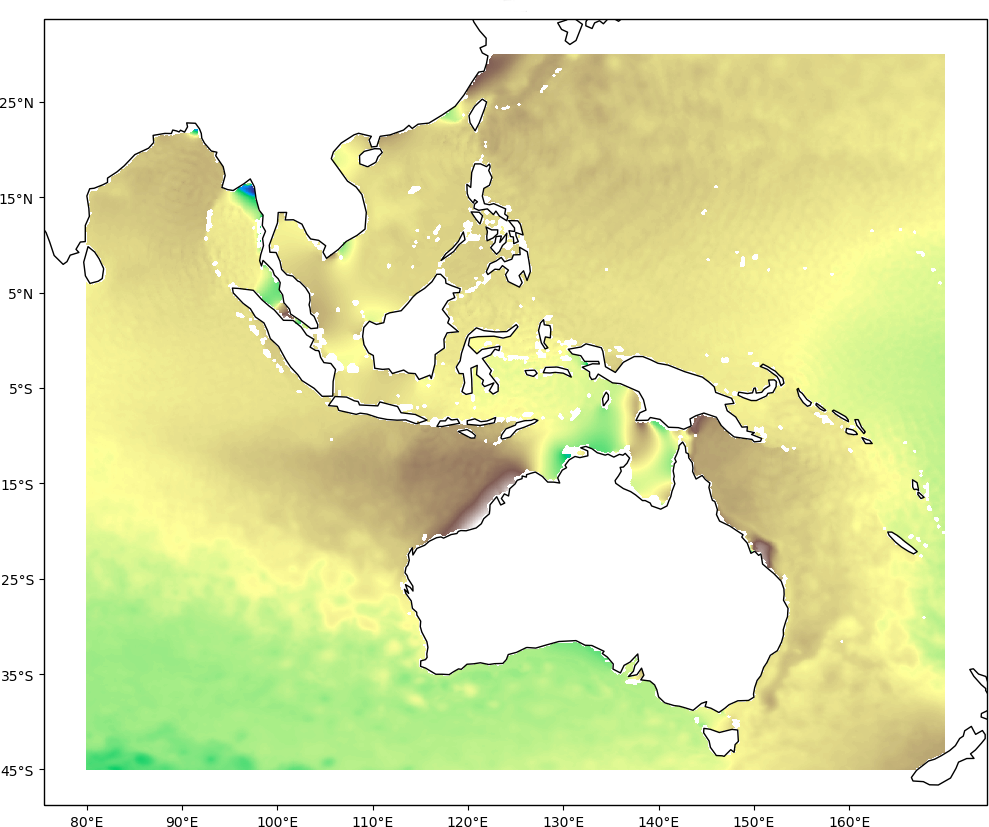Note
Go to the end to download the full example code. or to run this example in your browser via Binder
Interpolation of LLC4320 ocean model¶
Interpolation of LLC4320 ocean model
The interpolation of this object is based on a R*Tree structure. To begin with, we start by building this
object. By default, this object considers the WGS-84 geodetic coordinate system.
But you can define another one using the class Spheroid.
import cartopy.crs
import cartopy.mpl.ticker
import intake
import matplotlib.pyplot
import numpy
import pyinterp
mesh = pyinterp.RTree()
Then, we will insert points into the tree. The class allows you to add points
using two algorithms. The first one, called packing, will enable you to enter the values in the tree at
once. This mechanism is the recommended solution to create an optimized
in-memory structure, both in terms of construction time and queries. When this
is not possible, you can insert new information into the tree as you go along
using the insert method.
cat_url = ('https://raw.githubusercontent.com/pangeo-data/pangeo-datastore'
'/master/intake-catalogs/ocean/llc4320.yaml')
cat = intake.open_catalog(cat_url)
Grid subsampling (original volume is too huge for this example)
indices = slice(0, None, 8)
Reads longitudes and latitudes of the grid
array = cat.LLC4320_grid.to_dask()
lons = array['XC'].isel(i=indices, j=indices)
lats = array['YC'].isel(i=indices, j=indices)
Reads SSH values for the first time step of the time series
ssh = cat.LLC4320_SSH.to_dask()
ssh = ssh['Eta'].isel(time=0, i=indices, j=indices)
Populates the search tree
mesh.packing(
numpy.vstack((lons.values.ravel(), lats.values.ravel())).T,
ssh.values.ravel())
When the tree is created, you can interpolate data with two algorithms:
Inverse Distance Weightingor IDWRadial Basis Functionor RBF
Yon can also search the nearest neighbors on
the tree.
Note
When comparing an RBF to IDW, IDW will never predict values higher than the maximum measured value or lower than the minimum measured value. However, RBFs can predict values higher than the maximum values and lower than the minimum measured values.
In this example, we will under-sample the source grid at 1/32 degree over an area of the globe.
x0, x1 = 80, 170
y0, y1 = -45, 30
res = 1 / 32.0
mx, my = numpy.meshgrid(numpy.arange(x0, x1, res),
numpy.arange(y0, y1, res),
indexing='ij')
IDW interpolation
idw_eta, neighbors = mesh.inverse_distance_weighting(
numpy.vstack((mx.ravel(), my.ravel())).T,
within=True, # Extrapolation is forbidden
radius=55000, # In a radius of 5.5 Km
k=8, # We are looking for at most 8 neighbours
num_threads=0)
idw_eta = idw_eta.reshape(mx.shape)
RBF interpolation
rbf_eta, neighbors = mesh.radial_basis_function(
numpy.vstack((mx.ravel(), my.ravel())).T,
within=True, # Extrapolation is forbidden
k=11, # We are looking for at most 11 neighbours
num_threads=0)
rbf_eta = rbf_eta.reshape(mx.shape)
Let’s visualize our interpolated data
fig = matplotlib.pyplot.figure(figsize=(18, 9))
lon_formatter = cartopy.mpl.ticker.LongitudeFormatter(
zero_direction_label=True)
lat_formatter = cartopy.mpl.ticker.LatitudeFormatter()
ax = fig.add_subplot(121, projection=cartopy.crs.PlateCarree())
ax.pcolormesh(mx,
my,
idw_eta,
cmap='terrain',
shading='auto',
transform=cartopy.crs.PlateCarree())
ax.coastlines()
ax.xaxis.set_major_formatter(lon_formatter)
ax.yaxis.set_major_formatter(lat_formatter)
ax.set_xticks(numpy.arange(x0, x1, 10.0))
ax.set_yticks(numpy.arange(y0, y1, 10))
ax.set_title('Eta (IDW)')
ax = fig.add_subplot(122, projection=cartopy.crs.PlateCarree())
ax.pcolormesh(mx,
my,
rbf_eta,
cmap='terrain',
shading='auto',
transform=cartopy.crs.PlateCarree())
ax.coastlines()
ax.xaxis.set_major_formatter(lon_formatter)
ax.yaxis.set_major_formatter(lat_formatter)
ax.set_xticks(numpy.arange(x0, x1, 10.0))
ax.set_yticks(numpy.arange(y0, y1, 10))
ax.set_title('Eta (RBF)')
fig.show()
The image below illustrates the result of the IDW interpolation:
